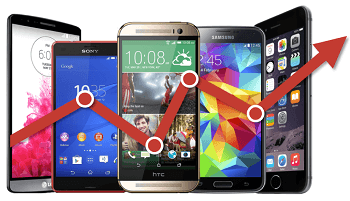Smartphone Prices Are Up – For Good Reason
Tia Winter | 21 November 2017 Purchasing the newest flagship phone has always been expensive, but it is common opinion nowadays that smartphones are becoming increasingly pricier. Depending on storage capacity, contracts, and other accessories, buying a new smartphone can well exceed the $1,000 mark, prompting many to wonder how much the coming generations of mobile phones and tablets could impact their pockets.
Purchasing the newest flagship phone has always been expensive, but it is common opinion nowadays that smartphones are becoming increasingly pricier. Depending on storage capacity, contracts, and other accessories, buying a new smartphone can well exceed the $1,000 mark, prompting many to wonder how much the coming generations of mobile phones and tablets could impact their pockets.
Even now, Samsung’s S8 is the company’s most expensive smartphone yet, and despite it following the disaster that was the S7 Note, the latest flagship phone’s presales still broke all of Samsung’s current records. With this in mind, there is definitely a market for high-end handsets despite their growing prices, but it begs the question of how mobile users in the mid-price range will be able to afford to upgrade as these devices become steadily more expensive.
Even taking inflation into account, the prices of today’s flagship phones seem quite high considering what they were just ten years ago. The wide range of carrier purchase choices, supply and demand, and regional changes can also create quite a high variance, with a great example being Samsung’s Galaxy S series.
Samsung’s lack of memory options that recently hit the US and Europe saw prices for the Galaxy S7 Edge skyrocket, and the cost of the new S8 Plus actually drop below that of the 128GB Galaxy S6 Edge. Regardless, the average price of flagship phones has increased by about $100 over the past 5 years, which is a considerable amount from any perspective.
However, contrary to popular belief, there are actually several good reasons why smartphones have burgeoned in price over the past few years. First and foremost is a general increase in the costs of hardware, due to greatly improved performance of hardware specifications and higher quality, more resilient plastics and other materials.
Extra Features Equal Extra Costs
Smartphones also offer a massively improved range of features nowadays, many of which require extra hardware and development resources. Fast charging tech, fingerprint scanners, stronger audio components, and other features have all taken their toll on the prices of smartphones, not even taking into account the growing costs of processor, display, or memory technology over time.
People today are now also willing to pay more for a smartphone that can accomplish more, so to speak. As the number and quality of mobile features have grown, so too have prices burgeoned for this technology due to hardware and development costs as mentioned above. However, the numerous new features and capabilities of modern phones also mean that users can streamline the number of devices they need to complete certain tasks – that is, a modern smartphone can do what previously required several different devices to achieve. From surfing the web to streaming movies, playing Denada Casino games or running a business, smartphones now have the capabilities to replace tablets, laptops and even, in some cases, desktop computers.
Android Police noted in a recent article that if we continue to demand good value for money and the best possible sets of features in our mobile devices, it is inevitable that the prices of these devices will continue to creep upwards.
The Birth Of The Mid-Tier Market
The increasing price of flagship phones has created one notable benefit: the mid-tier market. Those who are looking for a good smartphone with solid performance (but don’t require the latest and greatest features) have more choices than ever before thanks to part of the market that is offering high-end specs at prices much lower than those of the premium smartphone tier.
Often referred to as the ‘super mid-tier’ market, these mobile phones may not offer the best and newest technology, but their performances are similar to slightly older flagship handsets, making them appealing to the masses at much more affordable prices, often well below $700.
It is in this range of phones that the conventional wisdom about older technology falling in price can really be seen, as the dropping prices of non cutting-edge processors, memory and displays has created a whole new mobile market segment that simply did not exist ten years ago.
There are even entire smartphone brands, such as Huawei, HTC and Oneplus that are dedicated to serving the portion of the smartphone market that requires performance similar to the latest Samsung or iPhone, only at a fraction of the price. The Verge has even pointed out that the smartphones of these brands have a distinctly similar look, feel, and set of specs to that of last generation’s flagship iPhones, providing even more options for buyers in the mid-price range.
Conclusion: It’s All Up To Users
To conclude, it is not a myth that the prices of flagship smartphones have skyrocketed in recent years, despite the belief that technology is continuously dropping in price. However, for mobile users who require a cutting-edge experience and can afford the extra expenditure, the investment is often well worth it.
The incredible features, processing power, and specs of modern smartphones have made them even more versatile and handy, and for those who truly want to be able to carry a miniature computer in their pockets, there is simply no comparison. However, for those who are willing to settle for slightly outdated features and specs, the super mid-tier of the smartphone market offers plenty of devices with good, solid performance and features.
Essentially, it all boils down to each individual user’s needs and requirements from their smartphone of choice.
Source links: https://www.androidauthority.com/phones-gotten-expensive-762053/
http://www.androidpolice.com/2017/07/20/opinion-smartphones-getting-expensive-demanding/
https://www.theverge.com/2017/9/20/16338022/iphone-x-google-pixel-2-price-change

